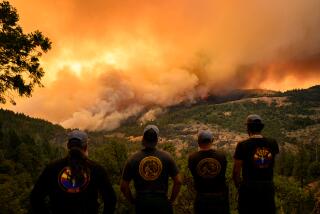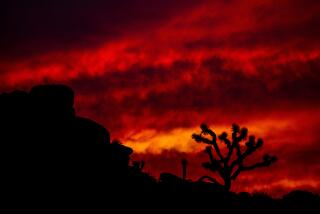Is the drought killing California’s giant sequoias?

- Share via
Reporting from SEQUOIA NATIONAL PARK — Sixty feet from the top of a giant sequoia named Kong, biologist Anthony Ambrose studied the foliage around him. Dense clusters of green leaves grew like shaving brushes from the branches, cones clustered like Indian clubs.
Topping out 25 stories above the ground, Kong was spectacular, an ancient beastly creature well-suited for its name. Its trunk at the base measured 17 feet across.
This broccoli top, Ambrose thought, was doing well, much like the other sequoias he had climbed.
Water and Power is The Times’ guide to the drought. Sign up to get the free newsletter >>
Ambrose is one of four biologists whose work in the trees this summer has led various media to report that the state’s drought could be killing one of California’s most famous treasures.
But researchers say those conclusions are wrong, or at least premature. Despite signs of stress — leaves turning brown after four hot and dry years — most of the sequoias seem to be holding up.
The browning foliage, first noticed last summer, brought Ambrose and fellow UC Berkeley biologist Wendy Baxter to the Giant Forest last month to try to find out what’s going on with the sequoias and, in the process, unravel the mystery of their internal plumbing: how these enormous trees use the water that’s available to them.
For 15 days, Ambrose, Baxter and another pair of climbers measured 50 trees and installed humidity and temperature sensors in the upper limbs. On Saturday, they returned for more studies.
Their research is one of three projects designed to help the National Park Service manage what is perhaps the best known forest in the world. Yet scientists know less about sequoias than more common species such as pines and firs, Ambrose said.
The drought has made the work more urgent. “It’s a good year to be a researcher, but a bad year to be a tree,” he said before the climb.
He tossed the end of a rope, weighed by a carabiner, over a higher branch and prepared for the next leg of his ascent.
The Giant Forest was named by naturalist John Muir, who walked through these groves more than a century ago. Its landmark, the 3,000-year-old General Sherman tree, is 100 feet taller than the Statue of Liberty.
Kong is younger, probably 2,000 years old, and Ambrose wondered what the future holds for the giant.
“These are tough trees, but we’re entering a whole new era,” he said.
::
Ambrose and Baxter were invited into the Giant Forest by the National Park Service, which is paying $50,000 for their efforts. Their work is being closely watched by Nate Stephenson, a research ecologist with the U.S. Geological Survey.
Stephenson has been studying many species of trees inside Sequoia National Park since 1979, and he doesn’t like what he has been seeing, especially at the lower elevations.
On a 21/2 -acre plot, 50 trees — a mix of sugar and ponderosa pine, incense cedar, white fir and oak — died in 2010. This year, 490 trees have died.
What lies ahead — El Niño or not — is not encouraging.
The drought is less important for its immediate effect than for its significance down the road, Stephenson argues. It may or may not be the result of global warming, “but what we do know is it is a preview of the future if warming continues.”
Given tree deaths at lower elevations, he wondered whether species higher up were suffering as well. The question took him into the Giant Forest last summer. He wanted to see if sequoia seedlings with their shallow roots were at risk.
Spending an hour on his hands and knees near Crescent Meadow, he kept finding a healthy population of young trees. But when he glanced overhead, he saw the brown leaves, lots of brown leaves, in some of the mature trees.
He didn’t know what it meant. Was it an adaptive mechanism or something more serious?
Working with the park service, he and his team mapped more than 2,000 sequoias throughout the park that were losing foliage. The Atwell and Garfield groves in the southwest corner of Sequoia seemed particularly hard hit.
In addition to Ambrose and Baxter, Stephenson enlisted researchers with the Carnegie Institution for Science to survey the forest from the air, using instruments that measure the water content of the trees.
Stephenson and his team will also oversee an analysis of tree rings taken from borings almost 25 years ago in the forest. He wants to know whether sequoias in different locations reacted differently to California’s cyclical droughts.
The goal is to create a “vulnerability map” of the Giant Forest that will enable the park service to consider solutions such as prescribed burns or manual clearances to eliminate trees that compete for water.
“Fires, droughts — these are processes that have always happened,” said Stephenson’s colleague, Adrian Das. “But in a context of a changing environment that we have affected, it is harder to argue that this is normal. If these events happen more frequently, it should make us think as a society what to do.”
::
At the top of Kong, Ambrose poked his head above the canopy, a complex of massive branches supporting a dense thatch of foliage and lichen. He wanted to take a panorama shot with his phone.
For a climber, the crown of a sequoia is a magical world that has only been studied in the last 30 years. Scientists say that it is as rich in life as an undersea garden and as difficult to reach.
Around Kong’s base lay ropes, carabiners, hooks, ascenders and daisy chains that Baxter and Ambrose use for their ascents. A hunting crossbow leaned against a fallen tree.
Preparation that afternoon began with Ambrose’s first shot and a flat-tipped arrow spooling out a gossamer of fishing line, 200 feet up and over a branch.
After replacing the monofilament with a climbing rope, he stepped into the saddle, a utility belt with foot straps. Like an inchworm, he pushed and pulled his way up the line.
Before heading down, he reached into his climbing sack and tied a temperature and humidity sensor onto a branch. Nearly 40 have been placed throughout the Giant Forest.
He and Baxter will retrieve these instruments after a few weeks and take clippings from the trees at night when they are asleep and during the day when they are photosynthesizing. The goal is to learn more about the physiology of the species and how much drought stress they can withstand.
Dying is often slow for a tree unable to draw upon water. Botanists call the process hydraulic failure.
Inside trunks and branches, water columns move from the roots to the leaves. These columns are like rubber bands, which snap when there isn’t enough water, Stephenson said. In response, trees close their pores, a process that deprives them of carbon dioxide.
“They starve,” he said.
Weakened trees, unable to expel intruders with sap, water and pitch, become hosts for fungi and insects such as the western pine beetle.
Sequoias, however, are different. Tannins in their bark protect them against insects, and they have a tremendous thirst.
A mature sequoia can suck up to 800 gallons of water a day (an average pine, 130 gallons), but it is not known how that water is used.
Does their size create an immediate demand? Or can the trees store water to draw upon during a drought?
Two days earlier, Baxter climbed a sequoia that was clearly suffering. Its foliage looked burned and crumbled in her hands. The drought seemed to be finishing off what a fire in 2009 had begun.
Yet they named this tree Lazarus because they hope it might rebound. What amazes them most about sequoias is their resilience.
The trees have lived for millenniums, through lightning strikes and blizzards, through fires, windstorms and severe drought, and no matter how beaten down they are, they endure, creating new crowns where old ones have broken and fallen.
But today’s environment could challenge this assumption, especially if temperatures continue to rise and snowpacks diminish further.
“The question is whether these giants will be able to rebuild themselves as they have in the past,” Ambrose said.
::
Driving along the Generals Highway into the park, Stephenson tried not to be discouraged. He estimated about a third of the oaks in the region are dead.
While the sequoias are getting the immediate attention, he believes their research will provide tools to help other species.
“In the end, we’re trying to understand the whole forest from top to bottom,” he said. He cites the loss of lodgepole and pinyon pine forests in Colorado and in the Southwest as a worst-case scenario.
At Big Fern Springs, he slowed down. The morning air filled with the scent of incense cedars.
For more than 30 years, he has passed through this grove and admired their ability to withstand seasons of fire and drought. He called them the immortals but is reconsidering.
“They’re getting hammered too,” he said.
Twitter: @tcurwen
ALSO:
Rough fire burns 32,000 acres of Sierra forest in march toward Hume Lake
Here are the California national parks you can go to for free today
#drylandsCA: The baby sequoais. He was worried about them.
More to Read
Sign up for Essential California
The most important California stories and recommendations in your inbox every morning.
You may occasionally receive promotional content from the Los Angeles Times.










